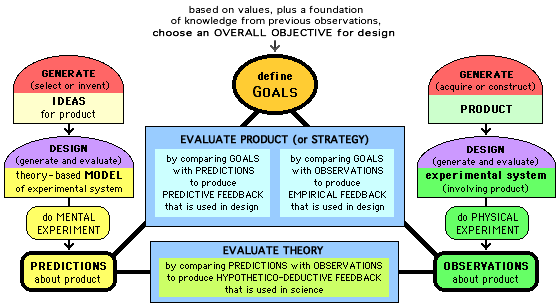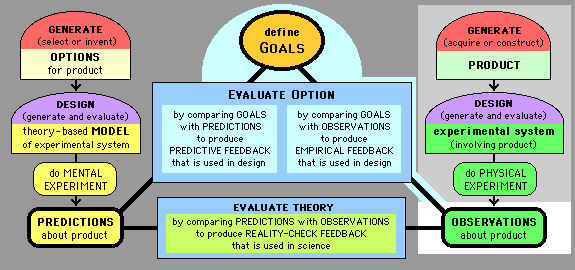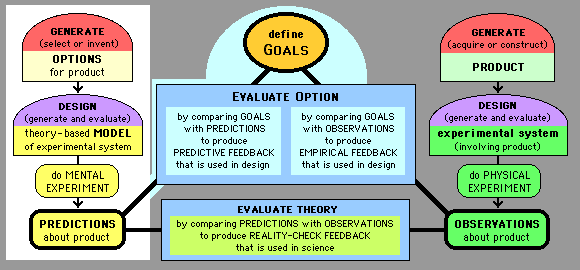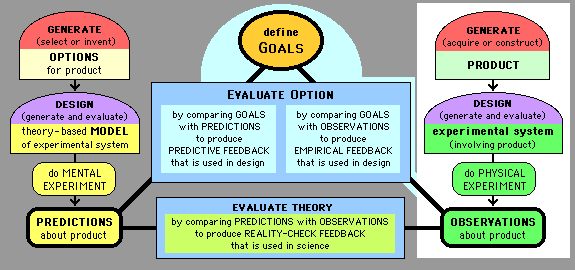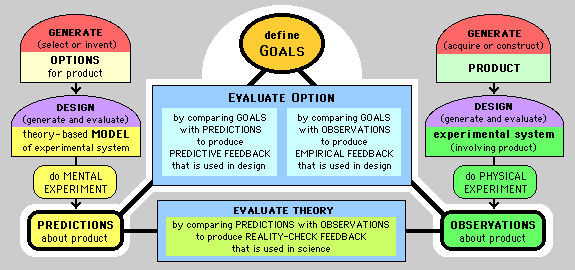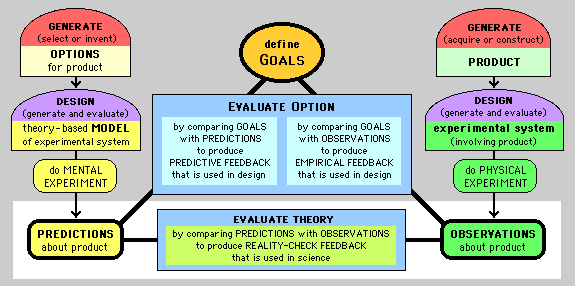note: In the
verbal descriptions of IDM, each element of the IDM-diagram is highlighted
in bold red print. Each important
concept that isn't in the diagram is in non-bold
red print.
1B.
DEFINE GOALS
A variety of goal
criteria — based on personal values about what is important
and what is good — can be used to decide whether a particular
type of goal-state is desirable. The criteria are personal because
"desirability is in the eye of the beholder."
If the overall objective is an improved
product (*), one way to define
a goal-state (or a set of goal-states) is to specify the desired properties for
a product in terms of its composition (what
it is), functions (what it does),
and performances (how well it performs
each function).
These three general criteria can
be split into sub-criteria that are more specific and concrete. For
example, functions might be durability
(Will it last?), appeal (Will people want it?), sales (Will people
buy it?), and cost (Can
we make it cheaply? Can we sell it for a profit?). The
corresponding questions about performance might
be: What level
of functioning (for being durable, appealing, sellable, durable, or
profitable) are you
hoping for in your most optimistic dreams, and what level would you
accept as minimally satisfactory? These levels define your range
of goals for performance.
If some criteria are in conflict,
how will you prioritize their relative importance? For example,
if increased durability requires increased cost, how will you balance
these conflicting factors? { It may be useful to think about
"balancing" early, or it may be more useful to delay this until later
when you are evaluating specific competitive options. At that
time, instead of trying to deal with vague generalities
you may be able
to
use specific information,
such as how much more it will cost to get a particular amount of increased
durability. }
* Designing
Products and Strategies
For simplicity, initially we'll
focus on the design of products. The
design of strategies is analogous, except for one main difference: While
designing a strategy it is often useful to think about consequences,
which are the properties of a future "state of being" that is
the result of a strategy. Other
than this, each time you see "product" just replace it with "strategy" and
you have a method for designing a strategy. { But the design
of a product is often accompanied by strategies, so the choice of
a particular product has consequences associated with it, as discussed later.
}
Moving
from Problem to PROJECT
Problem solving occurs
in three stages: A) recognizing that a problem exists,
that something could be improved and you have an opportunity to make
it better;
B) deciding to pursue a solution for this problem; C)
trying to solve the problem by achieving
an actual state that is a satisfactory match for the goal state.
Stage
A is discussed in Section 1A, and Stage C is the main theme of the
sections that follow. Between A and
C, however, an important decision must be made in Stage B. Why? Because
even when a problem has been recognized, this does not
necessarily mean that a solution
should be pursued. Since there are many problems, but
a limited amount of resources (people, time, money,...)
available for
solving problems, decisions about "what to do" are necessary.
Moving from a problem
(a potential project) to an actual project (in
which you actively pursue a solution) is a strategy-question that requires
evaluation and decision. You
must weigh the potential benefits and costs of one proposed project
(to achieve one overall objective),
compared with alternative projects (for other overall objectives),
and decide whether this project is likely to be a wise investment of
your resources.
In making this decision, you ask
questions about significance and practicality,
about the potential
benefits and costs, and the probability of a solution. / significance
questions: So
what? Why should we do it? What are the potential benefits,
and what are they worth? / practicality questions: Is
there hope? Are there rational reasons
to expect that our actions will
lead to a solution, that this problem can be solved using available
resources (people, time, money, materials,...) and your current knowledge
and technology? How much would a solution cost, in resources? / After
comparing these questions for different potential projects, you ask
"Is this project(s) the best use of our resources?" and
you "go for
it."
a
preview: The goal of Sections 2A and 2B is to help
you improve your skills in finding the best ideas for
designing a product (or a strategy), whether these ideas are old
or new. {
a reminder: You can see the "big picture" quickly
in A
Brief Overview of Design Method. }
2A. REMEMBER (SEARCH for old information)
During a problem-solving project, an important
part of solving a problem (by moving from an actual current state
to a desired goal state) is understanding the current
state more accurately and completely. While you're trying to
understand, you can also search for old (i.e., already existing)
product-options that may be a potential solution, because it may not
be necessary
(or productive)
to "re-invent
the wheel." This action is highlighted
in white below, in a diagram that is streamlined by omitting the initial
step of "Defining an Overall Objective: you
REMEMBER, you SEARCH for old information, for old observations
about products that may be options for a solution. |
| There
is also semi-white (light gray) behind three
elements: generate (acquire
or construct) a
product, design an experimental
system (involving
the product), and do
a physical experiment that produces observations
about the product. It
is semi-white because
when we ask "Are these actions necessary for remembering?"
the answer is YES and NO. Yes, it is necessary that someone did
these actions in the past, to produce the observations. No,
you don't have to do the experiments, if the information (the
observations, plus a description of the products and experiments)
can be found with
an information search of your
own memory or our collective human memory (in
books, websites,... and in other people).
Knowing how
to find information is
a skill that will become increasingly valuable in the future
due to the widespread use of modern information technologies.
Learning how to improve this skill — how to effectively use libraries,
the internet, databases, and other sources — is a good
investment of time. Here are a few suggestions: be persistent
(because a thorough search takes time, and usually diligence is
rewarded), well informed
(about the standard sources for finding particular types
of information), creative (to find non-standard sources), and critical
(to evaluate the reliability of sources). Be sociable and ask
for help from those who know about a particular field, and from reference
librarians who can help you find sources and develop strategies for
searching. Often, libraries offer workshops showing you how
to find information, and internet search services (and others) offer
suggestions for effective searching. { Later, maybe by the end of
2010, I'll provide links to web-pages about strategies for effective
searching.
}
A third highlighting,
aqua-colored, shows
that searching generates empirical feedback when you compare old
observations (from old experiments
on an old product) with your desired goals for
a product.
This feedback can stimulate and guide your search, when it
is used for questions about action planning,
for the long-term plans or just "what to do next." You
can ask: Have
I already found a satisfactory solution? Do
I have enough information? Has
my search been thorough, in breadth and depth? Does
it have enough breadth? (Have I checked a wide variety
of old products whose compositions and functions are similar, in one
or
more ways,
to
my goal product? Should I continue searching for more old products?)
Is there enough depth? (Do I have enough data about compositions,
and about the performances of each old product for each function?
Should I continue to search for additional data? of what types? ) For
action planning and product evaluation, information
tables are
useful.
During your review of what is already
known, you may find an old product (perhaps previously
unknown to you) that satisfactorily achieves your goals, and you consider
the problem to be solved. If not, you can move into an "imagining"
mode of action.
a comparison: In
2A you REMEMBER and observe (in physical experiments) for old products,
in 2B you INVENT and
predict
(in mental experiments) for new products.
• an
I.O.U. for the reader: I'm
continuing to post this page that is still "under
construction" because
it's better than what was here before I began the revision
(and there are many ideas that I think you'll find
interesting and useful) but
I wanted
to put in this disclaimer. I'm not sure when
it will be finished: maybe sometime in 2011 but not earlier. Until
then, at various places in the next few sections I'll comment
about the incompleteness so you can get an idea of what is worth reading (quite
a bit of it) and what is in rough form. / Eventually it will be re-structured to fit the new mode-numberings (beginning with 3A-3B-...) in my Overview of Design Method.
The first part of 2B is in
fairly good shape, although I haven't done a "second draft revision" of
it yet.
2B.
IMAGINE (invent new ideas)
To design,
you must generate and evaluate.
As shown below in white,
you can generate
ideas for a product in two ways — by selecting an old product (i.e., a product that already exists,
that you have found by searching) or by inventing a new product — and then you do
a mental experiment in which you make predictions
about the product. The aqua-area shows that your invention
of new options can be guided by the goal-directed
feedback you get
by
comparing goals with predictions. |
We'll look
at these actions in two phases: generating new options,
and making predictions so you can get
feedback.
Generating
New Options
To generate an option, you
select
an old option (that
you
remembered by searching in
2A) or invent a new option. Whether
or not an existing idea seems satisfactory, you can ask, "Could
we obtain a better product by continuing the process of inventing?"
How can you invent? Since
a "new
idea" is usually a variation of an old idea, invention
by revision (by modifying an old product to generate a new
product) is usually a useful strategy.
During invention by revision, a useful
sub-strategy is analysis. While
you're in a SEARCHING mode of action, reviewing the properties of old
products, think about the different parts of each product's composition,
and how changes in these parts affect the product's functions and performances. Search
for cause-effect relationships by asking, "How do changes in what
it is affect what it does and how well it does?" While you're analyzing
a variety of products, comparing their compositions and functions and
functional performances, thinking about similarities and differences,
you can search for correlational patterns and
scientific principles. The motivation for scientific theorizing
can be simply to construct new knowledge for its own sake, or to
construct the specific types of knowledge that
will help you invent a new product.
Stimulated and guided by these ideas,
you can systematically modify an old product in ways that will generate
a new product with the properties you want. Or you can modify
by combining parts from several old products. Or look
for ideas in other areas; look
at old products, parts, or principles that originally were intended
to achieve goals different than your goals, and think creatively
about how you can adapt a product that has been "imported from
another area" to help you achieve your own goals.
While you are "inventing by modifying"
you are guided by your goals. The purpose
of a goal-directed invention (or selection) is to find a product
whose
properties
will match your desired goal-properties. Let's
look at invention in science and design.
In
science, the
main strategy for goal-oriented invention
of a theory is a process of retroduction that
combines logic with imagination. In
contrast with cause-to-effect deduction that asks, "If this is a true theory,
then
what will the observations be?", retroduction asks
a
reversed
effect-to-cause question in the past tense: "These were the observations,
so
what
could
be the correct theory?" The essence of retroductive inference is
doing
thought-experiments, over and over, each time "trying out" a different
theory that is being proposed (by selection or invention) with the goal of producing
predictions that match the known observations. Basically, you are trying
to
find a theory that, if true, would explain what has been observed. To do
this, you are using a process of logic combined with creative imagining (for
inventing
a
new
theory)
or
remembering
(for
selecting an old theory).
In design, a similar process is used to find
a satisfactory
product or strategy. You do
thought-experiments, over and over, each time "trying out" a different
product that is being proposed (by selection or invention) with
the
goal
of
finding a product whose properties will
match the goal-properties you want.
During science you search
for a theory which will make predictions that match the known observations. During
design you
search for a product which will have properties
that match your known goal-properties. Do
you see the parallels, the similarities (and differences) in process? As explained above, goal-directed creative invention
is guided by critical evaluation. But it can be useful to weaken
the connection between invention and evaluation, at least temporarily,
by "playing games" that shift the balance in favor of creativity
for awhile. This is the strategy in a two-phase technique of
brainstorm and edit. First, during a brainstorming
phase you
minimize critical restraints to encourage a free flow of creative ideas. Later,
in an editing phase these ideas are critically checked for quality. During
the creative phase you can feel comfortable thinking freely — trying
to see in new ways and imagine new possibilities without
critical restraints — because you have the security of knowing that
any impractical ideas can be modified or discarded during the critical
phase. { If brainstorming is done in a group, a supportive environment
is important, since comments like "that's a stupid idea" will
not encourage colleagues to think or speak freely. }
The purpose of a brainstorm-and-edit srategy is to allow the
effective operation of both creative thinking and critical thinking. Both
are needed for effective design, but being overly critical, especially
in the early stages of generating ideas, can stifle creativity. We
shouldn't hinder the motion of a car by driving with the brakes on,
and we shouldn't hinder the flow of creativity by thinking with restrictive
criticism. A car needs brakes, and creativity needs the constraints
provided by evaluation, but brakes or constraints shouldn't be used
constantly. { But it would be more accurate and more useful to
consider the function of goal-directed evaluation to be steering, not
braking,
when it is used effectively. }
I've described two general approaches: tightly focused
goal-directed invention guided by evaluation (to produce GOOD ideas)
and free-wheeling
invention with minimal constraints (to produce LOTS of ideas). Which
approach is better? It depends on the people and the situation. Both
approaches can be useful,
and both can be used in synergistic combination, using each at different
times
in
the
process
of design. // IOU -- here are ideas to organize, revise, and use: naive ignorance occasionally allows out-of-box creative idea, but more often "a good way to bet" is knowing old info so you can have ideas for revision, and avoid wasting time by re-inventing the wheel / use components of past ideas / hopes for [visions of, dreams of, ideas about informed / // smooth shifting from one to another in ways that seem effortless and typically unconscious //
In this area of Thinking Skills, the resource-pages have
more information about creative thinking and critical
thinking and
combining
them in productive thinking.
The section below, about predictions,
is EXTREMELY ROUGH; part of it is the original, part is imported
from another page, and part is new (comments to myself, the start
of ideas,...).
Making Predictions and Getting
Feedback
Here, the goal-directed ------ is
to eventually get predictive feedback. goal is accurate truth, to get
------
After imagining a new product you
can make
predictions by
asking "What properties would it have?" To begin exploring this
question, a common strategy is to ask "What would happen if we used the
new product in old experiments?" Based on knowledge from the SEARCH
mode, select an experiment that has been done with old products. Then run
this experiment mentally with the new product, using "if...,
then..." logic: if the modified product was in this experimental
situation, then we would observe ___ . To fill in
the blank with a prediction, do a mental experiment:
construct a detailed mental model of the
experimental system (of the product in its experimental
context) and — by using everything you know about patterns
and principles (that are based on your knowledge of precedents,
on what you know has happened with old products in this experiment
or in similar experiments) and all you know about the new product — ask "What
will happen?" to produce predictions
about the product. basically, --- simplified
(from scientific-method.htm) { As explained in An
Overview of Scientific Method, predictions involve some
combination of theory-based deductive logic and experience-based
inductive logic. }
Now you can evaluate
the product by comparing goals with predictions to produce predictive feedback when you ask, "How well
does this new product match my goals for the product?" Predictive
feedback can stimulate several types of action. You may decide that
the new product is a satisfactory solution to the problem. Or you may
want to continue your search by doing goal-oriented invention of products,
design of experiments, or testing of products. These
three actions require creative-and-critical thinking, as described in the
next three subsections.
With either type of theory,
the if-then inference is similar. You think, "In this situation,
IF the system behaves as expected (according to the theory), THEN
we will observe ___" and what you put in the blank is your theory-based
prediction.
When scientists make an if-then
inference, they can move from IF to THEN in a variety of ways. They
might remember what has happened in the past, and estimate how similarities
and differences in situations (when comparing previous situations
with the current situation) will translate into similarities and
differences in observations. Or, if a theory includes an equation
or a model, they could substitute numbers into the equation and calculate,
or "run the model" in their minds or in a physical simulation or
computer simulation. If predictions can be made using several
methods, this will serve as a check on the predicting methods and
a cross-check on the predictions.
The parts below will be moved
and revised. The first few paragraphs will be moved into
2C (for designing of physical experiments) and then I'll refer
back to 2B. The second big part, with the TABLE, will be
moved into Section 3, and will become a main focal point (with
links to it from 2B and probably other places, since it can
be useful for inventing, action planning, experimental design,
evaluation,...).
Designing
Mental Experiments
The purpose of goal-oriented
invention of products is to achieve the main objective of design,
to obtain a product that satisfactorily meets your goals for desirable
product-properties. By
contrast, the purpose of goal-oriented invention
of experiments is to achieve a sub-objective, to obtain information
that will help you achieve the main objective of design.
In IDM the definition of "experiment" is
intentionally broad, to cover a wide range of situations: a
physical experiment is loosely defined as "an opportunity
to gather information" whether this occurs in a lab or outside,
whether there is an attempt to control variables or to
observe
a product "as it is" in an uncontrolled real-world setting.
There
are many possibilities. You
might want to focus on getting information about one property — such
as a car's acceleration, gas mileage, consumer appeal, paint durability,
or crash
safety — or
on testing one component of a multi-component product. / Or
you could do an approximation experiment that
has some characteristics (but not all) of an experiment that would
be
more realistic but less practical. For example, an experiment
might be run with a smaller scale-model of a large product, or a medical
test might be done with lab animals instead of humans.
Sometimes a visual organization
of information is useful. For example, the analytical
grid below
can summarize information (in the 20 yellow-green cells) about five
products
(in
the
top row) and four experiments (in the left column):
| |
Product A
(old)
|
Product B
(old)
|
Product C
(old)
|
Product D
(new)
|
Product E
(new)
|
|
Experiment 1 (old)
|
|
|
|
|
|
|
Experiment 2 (old)
|
|
|
|
|
|
|
Experiment 3 (new)
|
|
|
|
|
|
|
Experiment 4 (new)
|
|
|
|
|
|
Scanning horizontally across a
row shows the information that is generated, in one type of
experiment,
about five different products. Or you can scan vertically down
a column, to see how the properties of one product are revealed in
different
experimental contexts.
This grid shows products that are
both old and new, and experiments that are old and new. Each
cell can contain observations (if an experiment has been done already)
or
predictions, or both. You could think of it as a "product and
experiments" grid, but — since the result of experiments is information
about product-properties,
and properties are your focus during evaluation — it is probably more
useful to view it as a product-and-properties
grid.
For some products it is useful to
make several grids, one for each design decision. For a car,
decisions would include the type of body, trunk, seats, doors, colors,
engine,
and transmission. One grid could show possibilities for car bodies
(with different shapes, sizes, materials,...) and experiments (ways
to test each body for aerodynamic efficiency, consumer appeal, manufacturing
cost,...) along with observations and/or predictions. Other
grids could show information about trunks, seats,...
A grid is a useful way to summarize,
in a clearly organized way, knowledge about products and experiments.
By scanning horizontally or vertically, you can focus your attention
on a particular experiment or product. By thinking critically
and creatively about what you see in one scan — or in several
(horizontal, vertical, or mixed) — you can search for patterns
and principles, and for ways to improve a product by imagining (in
2B) how to revise an old option to make a new option.
Or
you may notice a knowledge gap when you ask, "Do the experiments
provide satisfactory information about all important properties
of every product-option, or is there something
else that we want to know but don't know?", and this will inspire
the design of new experiments (testing, in 2C) to generate the desired
knowledge.
Noticing a knowledge gap is an example
of an action decision. Each
cell in a product-and-experiment grid can be filled with predictions
or
observations, or neither, or both. For each cell, for each combination
of product and experiment, you can decide what is the best use of your
time: Should you invest the time that is needed to make a quick-and-rough
prediction? to make a careful prediction? to use a computer
simulation for making a careful prediction? to collect observations
by running a simple small-scale experiment, or an elaborate large-scale
experiment?
One important function of mental
experiments is to let you explore, quickly and cheaply, a wide variety
of experimental possibilities. One objective of this exploration is
to search for tests that seem capable of providing useful information,
that may be worth doing as physical experiments in a TESTING mode of
action, in 2C.
a detailed review: First, if you haven't done this
already, it will be useful to see "the big picture" in A
Brief Overview of Design Method. When you compare the
next three modes of action, you'll see that they are similar yet different: In
2A, observations are done physically with OLD OPTIONS (that already
exist); in 2B, predictions are done mentally with NEW OPTIONS. In
both 2A and 2B, you do mental evaluations. In 2A and 2C the process
is similar but not identical; the results are also similar, but
in 2A you get OLD OBSERVATIONS (about OLD OPTIONS), while in 2C you
get NEW OBSERVATIONS (about either OLD OPTIONS or NEW OPTIONS). {
At the end of 2C, there will be an overview-review. }
2C will be fairly
short, and needs fixing; the first paragraph was in 2B, and the
remainder will be revised.
Goal-Oriented
Testing of Products (Why?)
Information generated in the mind
(by prediction) is usually less reliable than information generated in
the real world (by observation). Therefore, it is often useful
to "do a reality check" by converting
a mental experiment into a physical experiment, to find out whether the "knowledge" being
constructed in your mind is accurate and true, whether it corresponds
to reality. 2C.
TEST (gather new information)
The modes of TESTING (to produce new experimental
information) and SEARCHING (to gather old information that was produced
in the past) are similar. But they always differ in timing, in
whether observations are made in the past or present. Another
important difference is that in SEARCHING you can often take advantage
of the experimental work done by others. Here is the TESTING
mode: |
| For
each
option (for each potential
product, whether it is old
or new, existing in the mind or in reality), designers use all available
information (from all experiments,
old and new, mental and physical) to evaluate
this product by comparing goals
with predictions (to produce predictive feedback) or comparing
goals with observations (to produce empirical feedback)
for the purpose of assigning an intrinsic status
that is an estimate of the extent to which this option achieves the
desired goals. Usually there is a competition between different
options, so a relative status (an estimate
for the quality of a particular option with respect to other options)
is also assigned.
Often, the design of a new product
is accompanied by strategies. For example, making and selling
a musical CD (a product) requires the coordinating of many strategies — for
artistic research and development (writing and arranging songs, and
deciding which ones to record), for rehearsing and performing, engineering
and production, financing and manufacturing, marketing and distributing — to
achieve objectives that are practical, artistic, and financial.
zb, one option may be do-able with manufacturing facilities you have
now, but another option would require new --- and financing, hiring
new people or laying off workers you already pay/hire, but might offer
potential for bigger profits (or more good done), or time,
different
futures, strategies for business and for personal living for people
who are making decision, or moving to another location, many interactions
and possible consequences possible, and all (or at least major) should
be considered, and being willing to accept uncertainties is often required
when making decisions, especially those involving strategies; for example,
choosing one product over another is a strategy for business, consider
consequences for self and for others, much environmental ethics is
about considering overall costs (whole other set of questions that
won't be examined here)
use "analytical grid" here? yes
Based on their estimates of status,
designers can make several types of decisions.
solution: They may
decide that one option is sufficiently satisfactory,
so they consider the problem to be solved. { But a "solution"
decision often leads to a new phase of problem solving that is an extension
of the old problem, such as deciding how to acquire or manufacture
the product, or how to market, distribute, and sell it. }
continue: Or they may
try to develop a product that is more satisfactory, with continuing
"research & development" action in the SEARCH, IMAGINE, and TEST modes. Perhaps
the evaluation process has narrowed the focus of this R & D
to revising a few key aspects of a few product-options that seem especially
promising. Or there may be an effort to search for new options,
or to generate more information about existing options.
abandon: Maybe things
are not going well and they abandon the search for a solution because
progress has been slow, or because despite good progress they
decide that working on another project is likely to be more productive.
delay: Or they can
abandon the process of R & D temporarily, intending to return later,
so
they can work on other projects for awhile. Or perhaps a delay
will be productive without an investment of their own time and effort.
This could occur, for example, if at a later time they will be able
to use information or technology that
in the future will
be available due to the work of others.
settle: Sometimes, however,
an immediate decision is required even though none of the available
options is totally satisfactory, so they "settle for less"
and choose the best available option, if this is better than a delay.
Or perhaps, even if an immediate decision isn't absolutely necessary,
a delay would cause significant disadvantages. { When it seems
wise to make a quick decision, even though evaluation indicates that
only a conclusion of "inconclusive" is warranted, maybe they
can make the decision in a way that takes into account the uncertainties.
}
re-aim: Based on what
they have learned during the process of R & D, they may decide
to modify the goal-state. Maybe their original goals now seem
impractical and too difficult to achieve, so the standards for a
satisfactory product
are lowered and they are willing to settle for less. Or the standards
can be raised (or changed) if they have recognized or invented new
possibilities
for a product with characteristics that are better (or just different)
than what they initially could imagine. Or perhaps, based on
revised estimates of relative importance, there is a change in the "weighting
emphasis" for different types of goal-criteria, which leads
to revised strategies for achieving an optimal balance between conflicting
criteria.
diversify: But a change
of plans isn't limited to only revising goals for the current project. Designers
can also generate new projects based on new Overall Objectives,
for related "spinoffs" or for ideas unrelated
to the current project.
As discussed earlier, many results
of evaluation involve not just the product, but also decisions about
action, about "what to do next." This important aspect
of design is discussed later, in The Generation and Evaluation of
Actions.
4. THEORIZE
In a step that is optional
— that is not necessary when developing a product, but is often
helpful
— a designer evaluates a theory by comparing predictions with observations to produce
hypothetico-deductive feedback. This reality
check is the key step in theory evaluation, in deciding whether
"the way things are (according to theory-based predictions)"
correspond to "the way things really are (as indicated by observations)." |
| A
ROUGH-DRAFT SUMMARY BEGINS HERE:
At this time I've decided
to work on other projects, so I'll just describe what eventually will be
in this page. There will be minor revisions (as described later)
and six end-of-page sections, briefly outlined below:
The
Design of Strategies: The same basic process is used for
designing products and strategies (*). In
all current descriptions of IDM, the focus is restricted to
products
in
order to increase
the
clarity and to decrease the need for awkward phrases like "product
and/or strategy." But most of the action that occurs when
designing products also applies to the design of strategies, so you
can just replace each reference to "product" with "strategy" and
you'll have the design process for
strategies. But one major difference is a shift,
when predicting or observing, from properties (of
products) to consequences (of strategies). Eventually,
this section will examine the similarities and differences between
the process of design for products and for
strategies. {* As described
at the beginning of An
Introduction to Design, strategies can be designed
for a wide variety of situations, ranging from business to basketball,
from romance to
public policy. } {back to Section 1B}
Generating and Evaluating Actions:
A strategy can be the overall objective of design, as in the previous section.
But strategy planning also occurs within the process of design when
— guided by feedback that enhances their awareness of differences
between the current state and the goal state, and perhaps constrained
by the limitations
of deadlines and budgets — designers generate, evaluate, and
execute actions that will help them make progress toward solving their
problem.
Strategies for action begin during the planning for a design project. Later,
during the process of design, these preliminary plans can be modified
by improvised planning. { Currently, these ideas are much more
fully developed in my model for Integrated Scientific Method,
in the section about Problem-Solving
Projects. }
Modes of Action: This
will expand the earlier discussion (in Section 1A) about interactions
between modes
— with problem recognition requiring action in the modes of searching,
imagining, evaluating, and defining goals — and will extend it to
other
interactions.
Actions and Methods: This
section, which is especially important for education, will explore
the relationships between thinking methods for problem solving
(such as those summarized in IDM) and the thinking actions (such
as various applications of creative and critical thinking) that are
used during the process of problem
solving. We'll look at some actions, plus different perspectives
on the relationships between methods and actions. / Here
is a summary of the difference between a thinking process (which I'm
calling a "method") and thinking skills: "What
we call thinking skills are simpler
cognitive operations such as observing, comparing, or inferring." A thinking
process "involves using a
sequence of skills intended to achieve a particular outcome." A
process "orchestrates numerous skills" and
is directed toward achieving an objective. Compared with a skill,
a process "is broader in scope, and takes
a longer time to complete." {from my page about Comparing "Thinking Skills" Frameworks which uses quotations from Dimensions
of Thinking: A Framework for Curriculum and Instruction (1988) }
Enriching IDM: IDM
can be supplemented with ideas from ISM (Integrated Scientific Method) — such
as cultural-personal factors, thought styles, conceptual factors,
and
more — to
produce an enriched model of IDM. Even though IDM is
simpler than ISM, design is not simpler than science, so enrichment
is appropriate
and useful.
Also, there will be minor revisions
in Section 3 — mainly by adding an "evaluation analysis"
grid that has options on one axis, criteria [weighted for importance]
on another axis, and evaluations in the cells) — and Section 4 (with
miscellaneous comments), and in a few other places.
Science and Design: This
will flow naturally from the THEORIZING mode. And it will be
an extension of a discussion that begins on the "Introduction
to Design" page, which: 1) makes a distinction between
the designing of products or strategies (which I'll call "design")
and the designing of theories (which I'll call "science"); 2) discusses
some similarities and differences between engineering [as one type
of design] and science; 3) suggests that it may be useful
to consider one type of comparison (of predictions with observations)
as being a useful form of feedback in science, while two other comparisons
(of predictions with goals, or observations with goals) are useful
for feedback in design, as shown below: |
